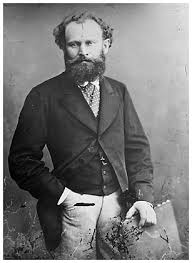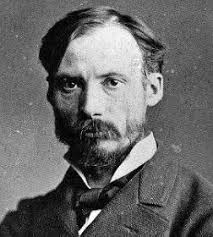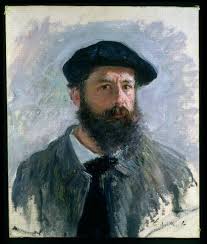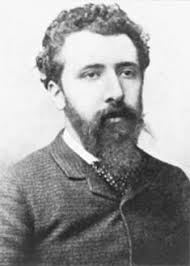Vincent van Gogh.
I girasoli, 1888, Londra.
National Gallery

 His posters have made history, one of the most famous Moulin Rouge, La Goulue, a new era, the advertising graphics. The poster was an immediate success and introduces some great novelty, reminiscent of a sign written in red with a solution of the big M and the repetition of words, the perspective distortion of space, globes of gas lamps, the idea of \u200b\u200bthe public placed in a semicircle. Henri Toulouse combines different suggestions, mediating the simplicity and stylization of Japanese prints, key to understanding the artist's work. "Toulouse, became interested in lithography in 1891, in ten years will create more than 360 that shows the 'the artist's commitment in this area. Lautrec for his graphic works is a proper completion of the work depicted. A lot of originality not matched by a real appreciation from the critics and the public, which does not include the changes introduced by the artist. Toulouse, died at only thirty-seven years syphilis.
His posters have made history, one of the most famous Moulin Rouge, La Goulue, a new era, the advertising graphics. The poster was an immediate success and introduces some great novelty, reminiscent of a sign written in red with a solution of the big M and the repetition of words, the perspective distortion of space, globes of gas lamps, the idea of \u200b\u200bthe public placed in a semicircle. Henri Toulouse combines different suggestions, mediating the simplicity and stylization of Japanese prints, key to understanding the artist's work. "Toulouse, became interested in lithography in 1891, in ten years will create more than 360 that shows the 'the artist's commitment in this area. Lautrec for his graphic works is a proper completion of the work depicted. A lot of originality not matched by a real appreciation from the critics and the public, which does not include the changes introduced by the artist. Toulouse, died at only thirty-seven years syphilis.
*****
I girasoli, 1888, Londra.
National Gallery
Nel 1886 è un anno chiave for art in Paris, then the undisputed capital of the European School. The pointillist
contributes to the emergence of new languages \u200b\u200bfor the future development of artistic creation. The original style of Paul Cezanne, is increasingly becoming more and more significant results with becoming a point of reference for the new generations, by Paul Gauguin, who is still seeking its own artistic language, but already interested in painting a synthetic, highly symbolic.
In that period he worked in Paris Herri de Toulouse-Lautrec, a man become a legend because of its short fictional biographer, sensitive singer of Parisian nights and clever inventor of posters of surprising modernity. In 1886 Vincent van also comes Gong and its unique language will leave a deep mark on the European scene, sowing the seeds for the birth of the expression of them upset about the artistic circles in France and Germany.
The expressions are not easy to label, artists are free of any membership group.
These new artists express a new way of seeing and hearing. Art is no longer a retinal and simply record the external reality, the impressions of truth, the artist looks into looking at the answers himself, transforms, translates information that the eye provides, enriching or simplifies a new era is dawning The "big eye" of Monet to capture the subtle variations of true, is not enough. The term has already passed the impression, the time of avant-garde is now at hand.
*****

The short life of Henri de Toulouse-Lautrec , has the flavor of a novel and can be used as few others in the narrative. This aspect too has contributed to the fame of the artists who best embody the common imagery of life in Paris. Beyond lights and shadows of his character, Toulouse is a painter of the highest level, an extraordinary inventor of billboards and very modern printed works that are innovative graphics solutions. Born in 1864, from a noble family, he started painting as a result of immobility due to poor health forced, un'osteogenesi imperfect nature of genetics is causing his frequent bone fractures, and stop its growth to 150 cm in height. In 1886 he moved to Paris, the economic independence also marks the start of a brilliant and brief career as an artist. Admirer of Degas he devoted mainly to scenes of daily life in Paris by night. If the issues are similar to those of Degas, the aproccio is different. Seconded the eye of the master impressionist is replaced by that of Henri Toulouse-sensitive. To understand the difference between the two eyes, is enough to compare the works of Degas to the female toilet and one of the best known oils of Toulouse. The toilet in the first image gives the impression of spying in the lock, the second in spite of the position behind the subject and the atmosphere of a quiet complicity between artist and model. Few artists have managed to portray the daily life with stunning immediacy. The bed is a real snapshot of disarming truth cultured without malice can suggest the complexity of a lifetime in the short space of a sheet.
 His posters have made history, one of the most famous Moulin Rouge, La Goulue, a new era, the advertising graphics. The poster was an immediate success and introduces some great novelty, reminiscent of a sign written in red with a solution of the big M and the repetition of words, the perspective distortion of space, globes of gas lamps, the idea of \u200b\u200bthe public placed in a semicircle. Henri Toulouse combines different suggestions, mediating the simplicity and stylization of Japanese prints, key to understanding the artist's work. "Toulouse, became interested in lithography in 1891, in ten years will create more than 360 that shows the 'the artist's commitment in this area. Lautrec for his graphic works is a proper completion of the work depicted. A lot of originality not matched by a real appreciation from the critics and the public, which does not include the changes introduced by the artist. Toulouse, died at only thirty-seven years syphilis.
His posters have made history, one of the most famous Moulin Rouge, La Goulue, a new era, the advertising graphics. The poster was an immediate success and introduces some great novelty, reminiscent of a sign written in red with a solution of the big M and the repetition of words, the perspective distortion of space, globes of gas lamps, the idea of \u200b\u200bthe public placed in a semicircle. Henri Toulouse combines different suggestions, mediating the simplicity and stylization of Japanese prints, key to understanding the artist's work. "Toulouse, became interested in lithography in 1891, in ten years will create more than 360 that shows the 'the artist's commitment in this area. Lautrec for his graphic works is a proper completion of the work depicted. A lot of originality not matched by a real appreciation from the critics and the public, which does not include the changes introduced by the artist. Toulouse, died at only thirty-seven years syphilis. *****
*****
Paul Cezanne . The father of modern
*****
*****
Paul Cezanne .
Apples and oranges-1895-1900
Paris, Musée d'Orsay
 Paul Cèzanne nasce a Aix-en Provence nel 1839. Suo padre è un fortunato commerciante di umili origini che grazie alla propria abilità negli affari, arriverà a possedere l'unica banca della città; all'ascesa economica non ne corrisponde una sociale: gli arricchiti Cèzanne non godrà mai della considerazione dei propri concittadini. Compagno di scuola di Zola, che rappresenta per il pittore un importante riferimento culturale e affettivo Paul abbandona presto gli studi per dedicarsi alla pittura. Parte per Parigi dove viene accolto con ostilità: il suo carattere scontroso e ostentatamente rozzo, cosi poco avvezzo alle raffinatezze cittadine, si accompagna a un linguaggio artistico incomprensibile anche agli spiriti più colti. Il lato oscuro Cezanne's good is evident in his early works, never completely subsided even in maturity. First encounter with impressionism whose works are Maddalena (1869 Paricio about Musée d'Orsay) or woman strangled of 1870-1872, Paris, Musée d'Orsay), both works highlight a particular aspect of the work of visionary Cèzanne.Le scenes painted in the seventies-all: The orgy (pictured right)
Paul Cèzanne nasce a Aix-en Provence nel 1839. Suo padre è un fortunato commerciante di umili origini che grazie alla propria abilità negli affari, arriverà a possedere l'unica banca della città; all'ascesa economica non ne corrisponde una sociale: gli arricchiti Cèzanne non godrà mai della considerazione dei propri concittadini. Compagno di scuola di Zola, che rappresenta per il pittore un importante riferimento culturale e affettivo Paul abbandona presto gli studi per dedicarsi alla pittura. Parte per Parigi dove viene accolto con ostilità: il suo carattere scontroso e ostentatamente rozzo, cosi poco avvezzo alle raffinatezze cittadine, si accompagna a un linguaggio artistico incomprensibile anche agli spiriti più colti. Il lato oscuro Cezanne's good is evident in his early works, never completely subsided even in maturity. First encounter with impressionism whose works are Maddalena (1869 Paricio about Musée d'Orsay) or woman strangled of 1870-1872, Paris, Musée d'Orsay), both works highlight a particular aspect of the work of visionary Cèzanne.Le scenes painted in the seventies-all: The orgy (pictured right)
 (around 1870 private collection) which reveals all the contradictions and fears of a difficult man inwardly unresolved, for which the sexual and emotional relationships are still a painful battlefield. The paintings of this period are particularly interesting for understanding the artist and his work.
(around 1870 private collection) which reveals all the contradictions and fears of a difficult man inwardly unresolved, for which the sexual and emotional relationships are still a painful battlefield. The paintings of this period are particularly interesting for understanding the artist and his work.
The portrait is a genre very popular artist, from the beginning. The youthful portrait of her father, learned while reading the newspaper in an armchair at home gives us an extraordinary example, the apparent calm hides once again the complexity of a difficult family relationship: "L'événement" is the newspaper in which Zola publishes his articles in defense of the Impressionists, writings hardly have received the sympathy of his father, adamantly opposed to the son's departure for Paris and his vocation as an artist. It is no coincidence that, at his back, face fine show whether, on the wall, a still life painter, a painting that really exists: Sugar Pears and blue cup (1865-1866 - Paris Musée d'Orsay) Works
the next with Paul Gauguin and Vincent van Gogh
apples make their appearance in the work of Cezanne in the seventies and became, in later years, one of the most popular subjects of the artist. Cezanne's style in painting fruit has charmed critics and writers, is known, the opinion of the writer Virginia Woolf observes that As you look more like apples of Cezanne, the more apples seem to become more red and more green and round and their heavy pigment itself seems to defy, we touch some nerve, stimulate, excite words inspire in us where we did not believe that words exist, suggests ways in which the first did not see that yet. In this wonderful canvas
nothing is left to chance, the objects and fruits are arranged in space according to different angles, along a diagonal, giving a balanced but very complex multiplicity of points of view.
nothing is left to chance, the objects and fruits are arranged in space according to different angles, along a diagonal, giving a balanced but very complex multiplicity of points of view.
*****
 Paul Cèzanne nasce a Aix-en Provence nel 1839. Suo padre è un fortunato commerciante di umili origini che grazie alla propria abilità negli affari, arriverà a possedere l'unica banca della città; all'ascesa economica non ne corrisponde una sociale: gli arricchiti Cèzanne non godrà mai della considerazione dei propri concittadini. Compagno di scuola di Zola, che rappresenta per il pittore un importante riferimento culturale e affettivo Paul abbandona presto gli studi per dedicarsi alla pittura. Parte per Parigi dove viene accolto con ostilità: il suo carattere scontroso e ostentatamente rozzo, cosi poco avvezzo alle raffinatezze cittadine, si accompagna a un linguaggio artistico incomprensibile anche agli spiriti più colti. Il lato oscuro Cezanne's good is evident in his early works, never completely subsided even in maturity. First encounter with impressionism whose works are Maddalena (1869 Paricio about Musée d'Orsay) or woman strangled of 1870-1872, Paris, Musée d'Orsay), both works highlight a particular aspect of the work of visionary Cèzanne.Le scenes painted in the seventies-all: The orgy (pictured right)
Paul Cèzanne nasce a Aix-en Provence nel 1839. Suo padre è un fortunato commerciante di umili origini che grazie alla propria abilità negli affari, arriverà a possedere l'unica banca della città; all'ascesa economica non ne corrisponde una sociale: gli arricchiti Cèzanne non godrà mai della considerazione dei propri concittadini. Compagno di scuola di Zola, che rappresenta per il pittore un importante riferimento culturale e affettivo Paul abbandona presto gli studi per dedicarsi alla pittura. Parte per Parigi dove viene accolto con ostilità: il suo carattere scontroso e ostentatamente rozzo, cosi poco avvezzo alle raffinatezze cittadine, si accompagna a un linguaggio artistico incomprensibile anche agli spiriti più colti. Il lato oscuro Cezanne's good is evident in his early works, never completely subsided even in maturity. First encounter with impressionism whose works are Maddalena (1869 Paricio about Musée d'Orsay) or woman strangled of 1870-1872, Paris, Musée d'Orsay), both works highlight a particular aspect of the work of visionary Cèzanne.Le scenes painted in the seventies-all: The orgy (pictured right)  (around 1870 private collection) which reveals all the contradictions and fears of a difficult man inwardly unresolved, for which the sexual and emotional relationships are still a painful battlefield. The paintings of this period are particularly interesting for understanding the artist and his work.
(around 1870 private collection) which reveals all the contradictions and fears of a difficult man inwardly unresolved, for which the sexual and emotional relationships are still a painful battlefield. The paintings of this period are particularly interesting for understanding the artist and his work. The portrait is a genre very popular artist, from the beginning. The youthful portrait of her father, learned while reading the newspaper in an armchair at home gives us an extraordinary example, the apparent calm hides once again the complexity of a difficult family relationship: "L'événement" is the newspaper in which Zola publishes his articles in defense of the Impressionists, writings hardly have received the sympathy of his father, adamantly opposed to the son's departure for Paris and his vocation as an artist. It is no coincidence that, at his back, face fine show whether, on the wall, a still life painter, a painting that really exists: Sugar Pears and blue cup (1865-1866 - Paris Musée d'Orsay) Works
the next with Paul Gauguin and Vincent van Gogh
*****
*****
Stars. Silent spectators
of anger and joy
of terrible things
motionless companions of the lonely wanderer
the fisherman at night
of those awaiting a return.
To offer looks
joyful sparks.
Splendor spread. Want to light up
Stars.
Ember dispensers of hope
Dreams illuminate
range of colors in unexpected.
wink
Bright summer nights.
Recall blond sirens
for the novel Ulysses.
Stars.
In their magic dust
the beginning of time is enclosed
the mystery of the universe.
Anna Robert
thank my friend Anna, who with his verses, enhanced by pure poetry Soloimmagini.
thank my friend Anna, who with his verses, enhanced by pure poetry Soloimmagini.








.jpg)






